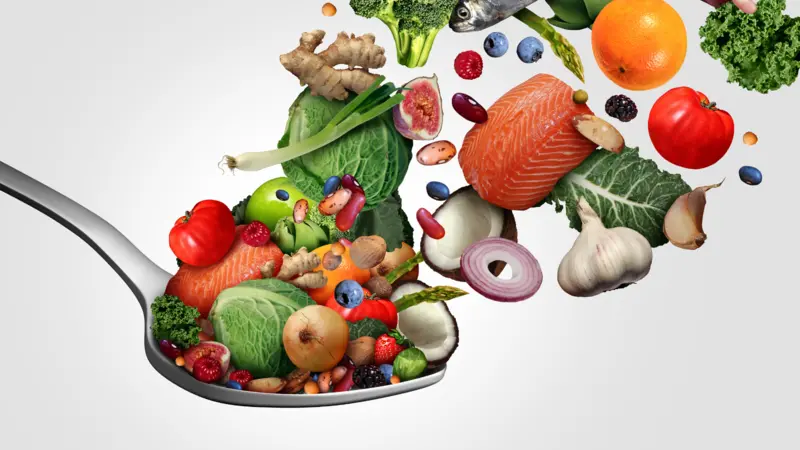
Conscious Eating
Conscious Eating
Cooling the Fire Within: Healthy Eating Tips to Ease Chronic Inflammation
Putting more thought into what we eat and why may be among the most important factors in determining how long we live. Researchers in Norway recently compared the long-term effects of a typical Western diet to an optimal one, and their findings can be a source for inspiration. The optimal diet had a substantially higher intake of whole grains, legumes, fish, fruits, vegetables and a handful of nuts, while reducing red and processed meats, sugar-sweetened beverages and refined grains.
According to their results, a sustained change from a typical Western diet to the better plan can make a big difference on life expectancy. Here are their predicted impacts on longevity for people after starting—and sticking to—an optimal diet:
Start at age 20—women add 8.4 to 12.3 years; men add 9.4 to 14.3 years
Start at age 60—women add 6.2 to 9.3 years; men add 6.8 to 10 years
Start at age 80—women and men add 3.4 years
So, it is never too late to start a positive activity.
This improved diet gets to the underlying causes of most of the reasons Americans die. According to the National Institutes of Health, 14 of the top 15 causes of death in 2019 were chronic inflammatory diseases. This means it is more than likely that the cause has existed for a long time under the surface (chronic), with too much inflammation for too long (inflammatory), affecting the brain, cardiovascular system, blood sugar system or wherever there is a genetic weak link (disease). Rather than ask what the ailment is, ask, “Where is the long-term, hidden inflammation coming from that is fueling this disease?”
Dr. George Slavich, founding director of the Laboratory for Stress Assessment and Research at the University of California in Los Angeles, says that understanding when inflammation promotes either good or poor health and how and when to intervene to reduce inflammation-related disease risk, “should be a top scientific and public priority.” Identifying and reducing individual triggers of inflammation opens a path to regenerating a healthier, younger individual.
Not all inflammation is bad. Time-limited increases in inflammation are critical for promoting wound healing and recovery, as well as reducing the spread of communicable infections. Humans would not have lived very long without a well-developed internal protection from threatening environmental triggers such as bugs, parasites, viruses, mold, fungus and bacteria. For better health outcomes, we need to address excessive systemic inflammation. There are many likely contributors to the fueling of inflammation, but one of the most common sources is what is on the end of our fork. Begin there.

Lifestyle Hack 1: If there is one prime directive for better health, it is to focus on living as much of an anti-inflammatory lifestyle as possible. Become more aware of the daily environmental exposures that ramp up inflammatory genes. Know, for example, what chemicals are used on the soil in which the food is grown or sprayed with before it is harvested. Then, armed with this knowledge, choose a better alternative, like organic and regenerative organic foods. As enough anti-inflammatory messages are accumulated, a reversal in the direction of health is possible.
Lifestyle Hack 2: Food is the most common source of gasoline on the fire of inflammation. Dr. Deanna Minich, president of the American College of Nutrition, recommends the Rainbow Diet, which acts like a fire extinguisher to put out the excess inflammatory fire in the body. Selecting multiple colors of fruits and vegetables at every meal tempers the inflammatory cascade. Strive over time to eat 50 different fruits or vegetables per week.
Begin today. Just bringing up to awareness the question, “Is this food inflammatory or anti-inflammatory?” will feed our health habits, and over time, healthier habits equal a healthier life.
KnoWEwell Chief Health Officer Dr. Tom O’Bryan, DC, CCN, DACBN, is an internationally recognized expert on gluten, bestselling author and speaker focused on food sensitivities, environmental toxins and the development of autoimmune diseases. He is a chiropractic doctor, certified clinical nutritionist and the founder of TheDr.com.
Anti-Inflammatory Meal Recipes

Zucchini Pasta with Salmon and Artichoke
Recipe for salmon and artichoke with gluten-free pasta made out of zucchini. Read More »

Artichoke and Spinach Greek Omelet
Start your morning off right with this healthy recipe for omelets packed with artichoke and spinach. Read More »

Curry Chicken Salad
This tasty recipe for curry chicken salad is packed with anti-inflammatory ingredients. Read More »


 By
By






